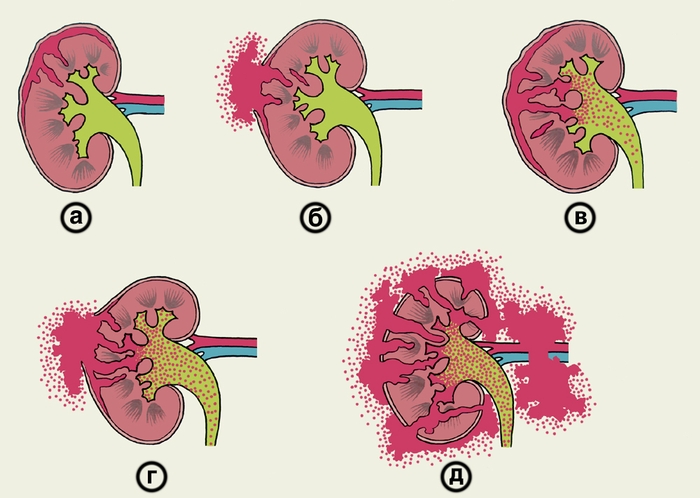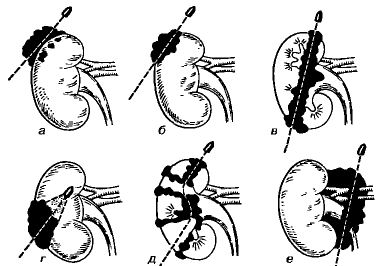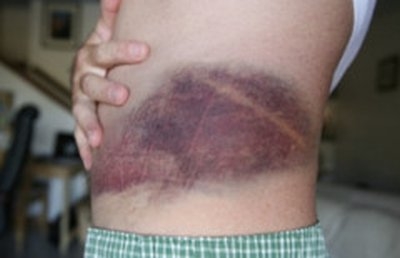Kidney injury: symptoms, consequences and treatment
The kidneys are a paired organ located outside the abdominal cavity, well protected from various adverse factors and external influences by the ribs and back muscles. Although the kidneys have excellent protection, at the same time, their damage, expressed in the form of bruises, can be observed. This type of injury is characterized by renal parenchyma and profuse hemorrhages. Kidney bruises are mainly observed during a fall. In medicine, a closed kidney injury is distinguished, as a rule, it can be obtained during a fall from a great height or after an accident, while playing sports. With an open injury, stab wounds can damage the kidney.
Kidney contusion is a serious injury requiring medical attention
If you start the causes of organ damage, then there are quite a few of them, the main ones are:
- Various household injuries with damage
- Falls on hard objects and grounds
- Bruised blows inflicted on the lumbar region
- Prolonged organ pressure
- Injuries after an accident with damage
Symptoms
Kidney injury resulting from damage to the organ, as a result of a blow or fall, is detected very quickly, since the symptoms appear instantly. The main signs that the kidney is threatened by trauma are:
- Significant swelling in the lumbar region
- acute pain
It should be noted that the damaged organ after injury is accompanied by pain, all the muscles above the kidneys hurt in patients, in addition to all this, hematuria is noticed, which is the main symptom of the damaged kidney. By observing the frequency of bleeding, specialists can determine the severity of the bruise.
Classification of kidney injuries
In medical practice, mechanical damage to organs is divided into:

Schematic representation of different types of closed kidney injuries: a and b - ruptures and hematomas that do not penetrate into the renal calyces and pelvis (a - without rupture, b - with rupture of the fibrous capsule); c and d - lesions penetrating into the calyces and pelvis (c - without rupture of the fibrous capsule, d - with rupture of the fibrous capsule); e - crushing of the kidney.
Closed injuries:
- kidney shock caused by trauma
- adipose tissue injury
- rupture in the damaged area of the pelvicalyceal system
- rush of muscles and organ capsules
- crushing process in the kidneys
- avulsion of an organ characteristic of injuries of the vascular pedicle
- contusion
Open injuries:
- shrapnel damage
- bullet penetration
- cold weapon injury
If we start to consider the characteristics of injuries, then they are different, combined with an isolated injury and with other injuries. Such damage can cause various disorders in organs, which differ in their complexity.
A huge role in injuries is played by the place of injury, strength, direction of injury. In this case, acute damage to the organ is characterized by rupture of tissues and muscles above the kidney, the damaged condition mainly occurs when there is a strong compression of the body, a fall on a sharp object or a blow to the lower back. The influence of all external factors provokes pressure on the kidneys between the ribs and transverse processes, a hydrodynamic change in the body is noticed, expressed by a significant increase in fluid pressure.
Any bruise is always characterized by the onset of injury, initially pathological changes in the organs were noticed, this can significantly complicate the process, causing a rupture of the kidney.
signs
The main indicators that there is damage to the kidneys, in the very first place, is the serious condition of the patient, which is accompanied by acute pain, significant bleeding, often there is an outflow of urine into nearby tissues of organs, urination processes may be disturbed, malfunction of other internal organs, various complications appear.
Therefore, if there was a bruise of the kidneys during a fall, then the manifestation of such symptoms as blood in the urine, significant swelling of the lower back and pain in the lower back will definitely come to light.
Pain can be characterized by a different condition - they can be sharp, dull and aching. In some cases, kidney injury during a fall in victims is manifested by bloating, nausea with vomiting, fever. Hematuria is considered the main indicator of kidney damage. In addition to all the above symptoms, kidney injury is complemented by absolutely non-standard characteristics, if considered from a diagnostic point of view, namely:
- Onset before the onset of final urinary retention due to blood clots
- Constant pain in the lower abdomen
- Malfunctions in the functioning of the gastrointestinal tract
- The presence of signs indicating the process of bleeding inside
- Fever

Gunshot wounds to the kidney. a - wound of the fatty capsule, b - tangential wound, e - penetrating wound, d - blind wound, e - crush injury, e - wound of the vascular pedicle.
Depending on the type of clinical picture established by specialists, there are 3 types of damage complexity:
- Mild trauma- the patient's well-being does not change much, slight back pain may be noticed.
- Medium organ injury- the patient has a satisfactory state of health, the only thing that can increase the pulse rate and lower blood pressure, the blood in the urine appears slightly. A huge accumulation of blood in the bladder provokes urinary retention. In the area of bruises, under the skin, in some patients, hematomas are noticed. As for pain, they are usually directed to the lower part of the peritoneum, the groin area, and the genitals. The ureters clogged with blood clots cause the formation.
- Severe kidney injury- collapse is determined, there are severe pains in the area of damage, in addition to this, bleeding inside can increase.
For pain, when there is suspicion of kidney damage, specialists first of all use the research method using the Nessler reagent, thus determining the presence of blood in the urine. With bruises, injuries, patients very often complain of back pain, which will have a different intensity of flow, since it directly depends on the complexity of the injury not only to the kidney, but also to other organs.
The pain is due to the fact that the abdominal muscles create natural resistance. Whatever the wound of the organ - closed or open, in any case, hematuria is detected, it is she who is the main indicator of injury. Blood clots enter the urine after an injury or bruise very quickly, so the patient already during the first urination, the urine will contain a significant amount of blood clots, and this, in turn, can provoke a bladder tamponade. The type of hematuria cannot fully provide reliable information about the volume and complexity of organ damage.
Diagnostics
Initially, geodynamic data are carefully studied to determine the injury to the organ. If their dynamics is considered unstable, surgical intervention is prescribed, if all indicators are stable, it is possible to conduct a complete study of the patient, and then prescribe treatment. As mentioned earlier, a bruised kidney is mainly indicated by the presence of blood in the urine, a painful sensation in the sides and in the lumbar region, as well as in the lower chest, swelling, significant muscle tension, partial fractures of the ribs.
Laboratory diagnostics includes:
- The study of hemoglobin
- Hematocrit control
- Detection of blood in urine
In addition, instrumental diagnostic methods are used, for this they carry out:
- Angiography
- Tomography
- x-ray
Diagnostics for closed wounds
Using all the clinical signs, complaints of the victim, anamnesis, doctors determine the complexity of the damage, in parallel with this, specialists determine the degree and nature of the damage, prescribe additional research methods. At the same time, in each case, a different method of examination is used and individual treatment is prescribed.

Hematoma from trauma
Diagnosis in open injuries
The basic principles of diagnosis in identifying open injuries of the kidneys are exactly the same as in closed injuries. The only thing in this case is that it is necessary to take into account not only the type of complexity, but also the use of many diagnostic methods, including intravenous urography and chromocystoscopy. Affected patients in this condition are prohibited from any transurethral diagnosis.
Laboratory diagnosis
When an injury of moderate complexity is detected, hematuria is observed in almost 98% of studies. In all cases, injuries to the organ of excretion of blood are insignificant. Thus, even if hematuria is not detected, in any case, urine tests should be studied. At the same time, the presence of creatine immediately after an injury cannot fully confirm that there is damage to the organ, its increase may indicate the presence of various kidney diseases. Constantly monitoring the dynamics of hematocrit indicators, additional hidden bleeding can be detected.
After an accident, there is a possibility of a traumatic wave, which extends not only to the kidneys, but also to the liver and muscles. Therefore, absolutely all victims with acute damage to the kidneys, chest, abdomen and lower back are prescribed radiation diagnostics.
Diagnosis with excretory urography
This type of research, as a rule, begins with an extensive radiograph of the kidneys, in addition to standard x-rays, a special substance is injected into the vein and additional pictures are taken. Carrying out the diagnosis of injuries also provides for the correct determination of the complexity of the injury.
Diagnosis of damage using ultrasound studies
At the moment, most clinics, when examining victims, use ultrasound diagnostics, which is considered the most complete and reliable. Basically, ultrasound is prescribed during the initial examination of patients, since this method allows you to detect fluid in the abdominal cavity. This type of diagnosis is considered effective only if the damage is moderate or severe, but if the patient has a minor injury, then it may not be detected. In the case when ultrasound diagnosis does not allow a full examination, chromocisoscopy is used.
CT scan
Recently, tomography has been used to study kidney injuries in patients who have stable hemodynamic parameters. It should be carried out both in the urographic and nephrographic phases. To identify urine inflows, a contrast fluid is injected intravenously and a scan is performed, after which the complexity of the damage is determined.
Treatment
A kidney injury or injury can be treated with both treatment and surgery. Before a treatment method is prescribed, a mandatory consultation with a urologist is carried out. If there are closed injuries of the organ or contusion of the right kidney, regular monitoring is carried out and the usual type of treatment is used. With open injuries, the use of conservative treatment is possible only in such cases:
- No significant tissue destruction
- Hematuria is short-term or moderate, the patient's condition is satisfactory.
Surgical intervention is prescribed when the injured kidney is isolated, and the general condition of the victim is satisfactory, and hematuria should be insignificant. Therefore, initially, a full medical supervision is carried out, tests are taken, and then an operation is prescribed.
If the injury is closed, then at the first stage, mandatory conservative treatment is carried out, which is aimed at instrumental manipulations, then an antibiotic is injected through the catheter, eliminating inflammatory processes in the walls of the pelvis of the organ. Patients are prescribed bed rest, a strict diet.
In medical practice, for minimal intervention, hematomas are drained, which takes place under the strict control of CT or ultrasound. It should be noted that it is endoscopic drainage of the organ that can reduce the outflow of urine and eliminate hematomas. If after such treatment, the consequences of a kidney injury show stable dynamics in patients, then they are additionally under observation for four weeks, after which a mandatory examination is prescribed several times a year.
1
Book a doctor now and do not postpone the problem for later.




